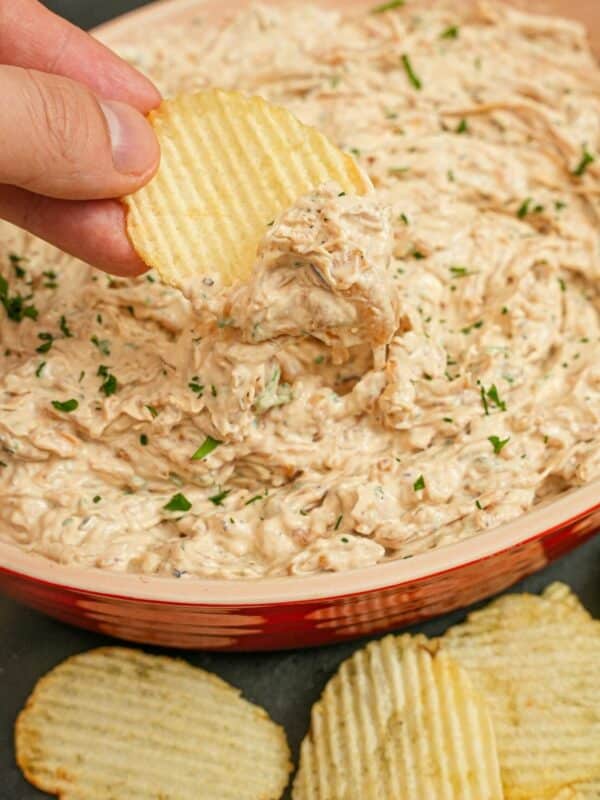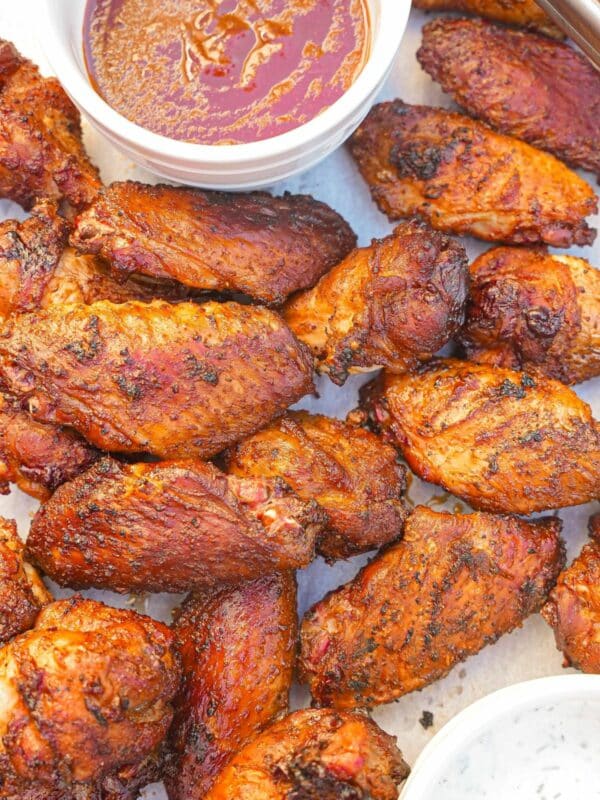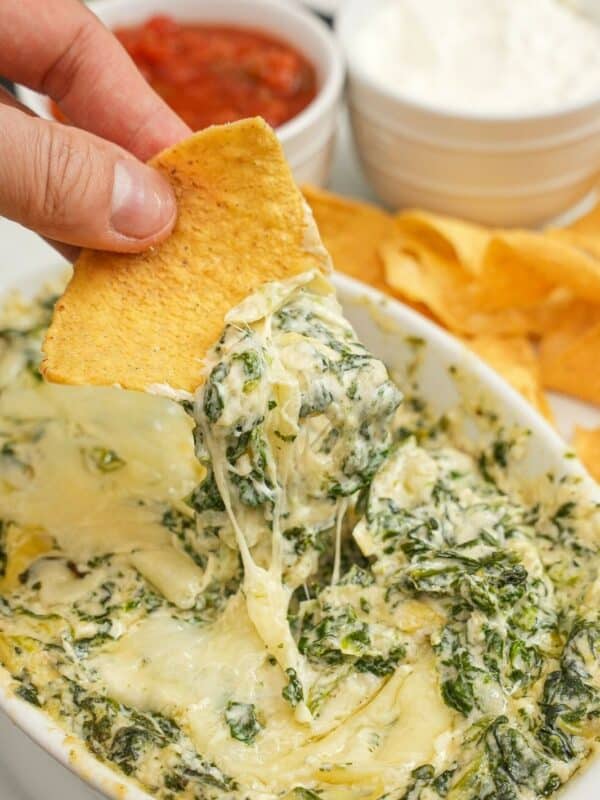Pasta alla Gricia – Authentic in 15 Min! (VIDEO)
This post may contain affiliate links. Please read our disclosure policy.
Pasta alla Gricia is one of the four Roman pasta dishes (the others being Carbonara, Amatriciana, and Cacio e Pepe)! It’s a beautifully creamy pasta dish with fresh pecorino cheese, a bit of pepper, guanciale, and emulsified pasta water to create an amazingly creamy sauce with without the use of any cream! The best part is it comes together in 15 minutes, so it’s perfect for a quick and easy meal!
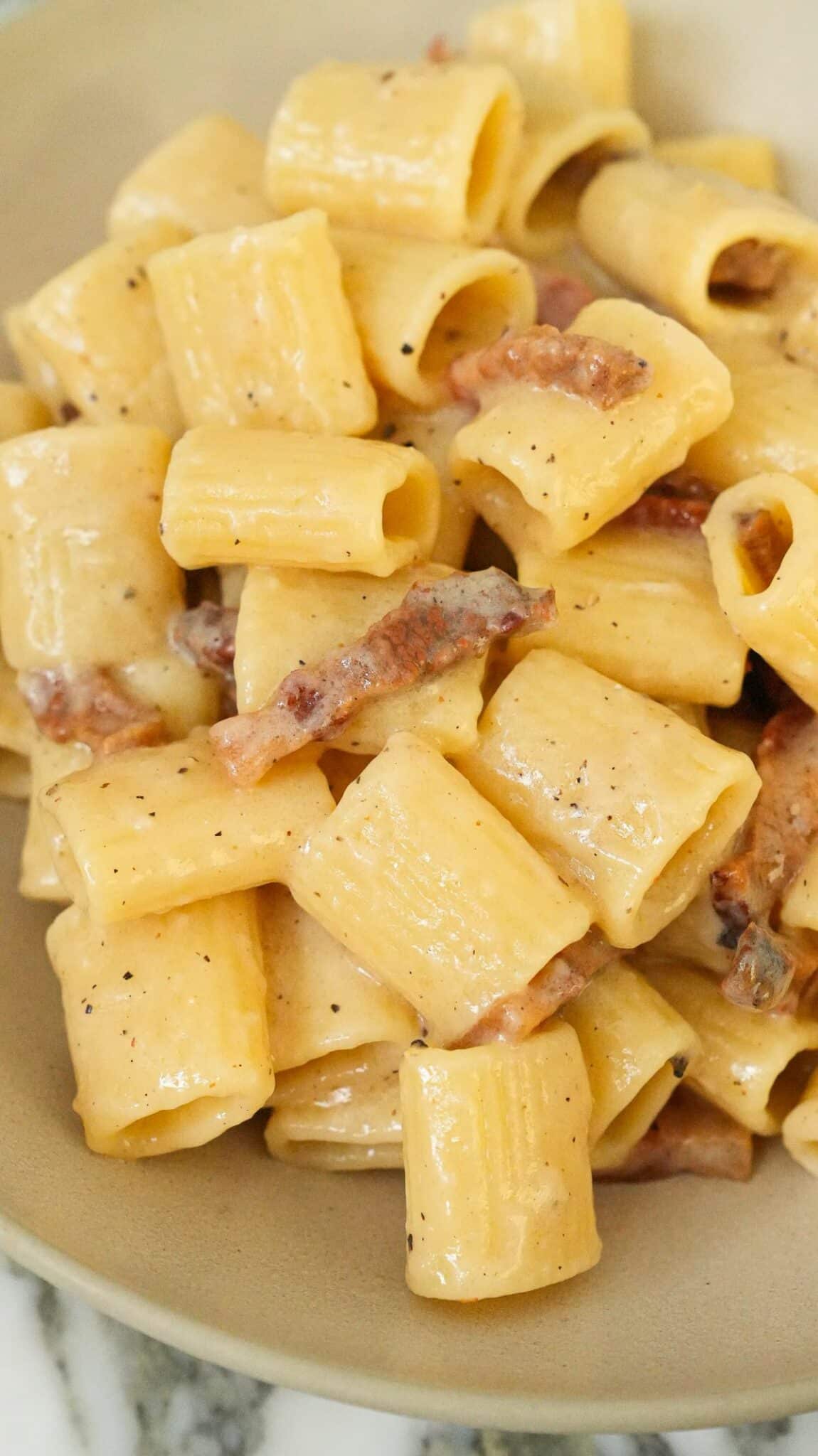
Watch the Pasta alla Gricia Recipe Video!
Table of Contents
Ingredient Tips for Pasta alla Gricia
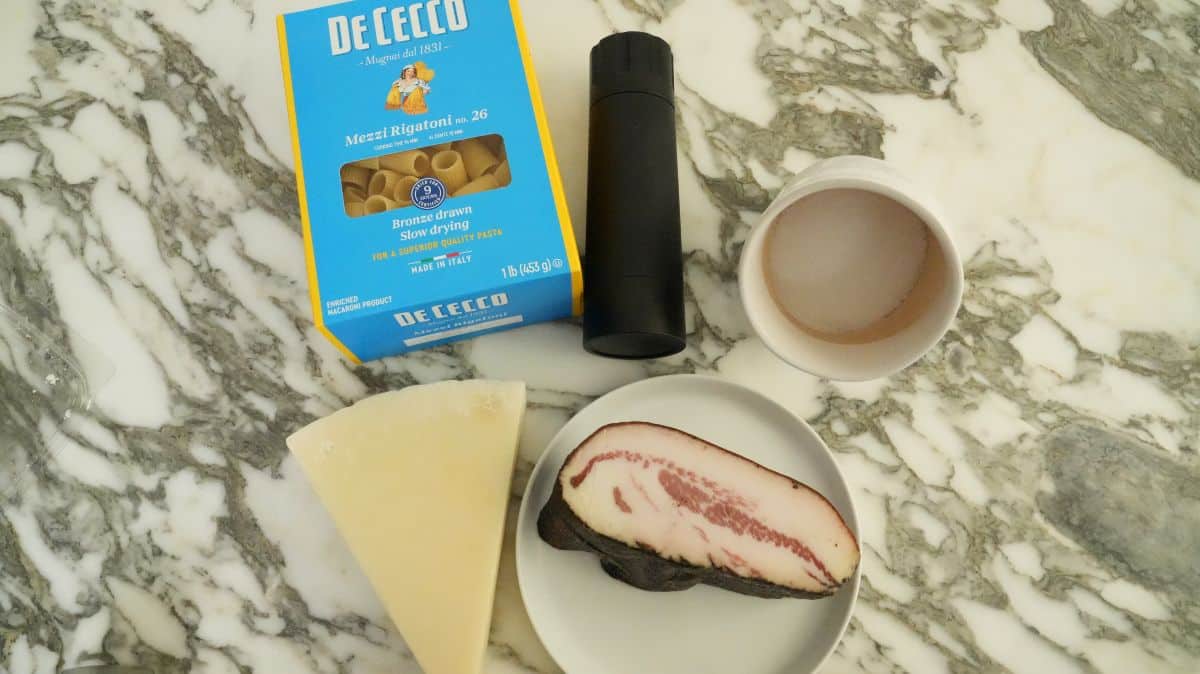
Refer to the recipe card for the full list of ingredients and measurements!
- guanciale – this is italian cured pork jowl, which has a pungent, peppery flavor and lots of fat which is key to emulsify the pasta sauce. If you can’t find guanciale, you can substitute for pancetta or bacon in a pinch
- kosher salt – used to salt the pasta water. I only use a 1/2 tablespoon for every 5 quarts of water used to cook the pasta. The cheese and guanciale is already salty, so you only want to season the pasta a little bit so the final dish isn’t too salty.
- freshly ground black pepper
- pasta – mezzi rigatoni, rigatoni, thick spaghetti or bucatini – a round tubular pasta is great for this recipe so that they creamy, emulsified sauce can become trapped inside the pasta (I prefer mezzi rigatoni, which is a short tubular pasta)
- Pecorino Romano, finely grated – this is an italian cheese made from sheep’s milk, which is traditional of this recipe. It’s also used in Carbonara and Cacio e Pepe
Recipe Instructions
1. Prepare the Guanciale and Pasta Water
Remove the tough outer rind from the guanciale with a knife. Slice the guanciale into ½ inch thick slabs, then into 1/4 inch wide strips.
2. Boil the pasta water and cook the pasta
Bring a pot of boiling water (4 quarts) to a boil. Add 1 tablespoon of kosher salt and add the pasta of choice. Cook the pasta until al dente.
3. Cook the Guanciale
As soon as the pasta is cooking, to a dry nonstick pan, add the guanciale. Turn the heat to medium high and cook the guanciale for 5-6 minutes until the guanciale is a deep golden brown and crispy and the fat has rendered.
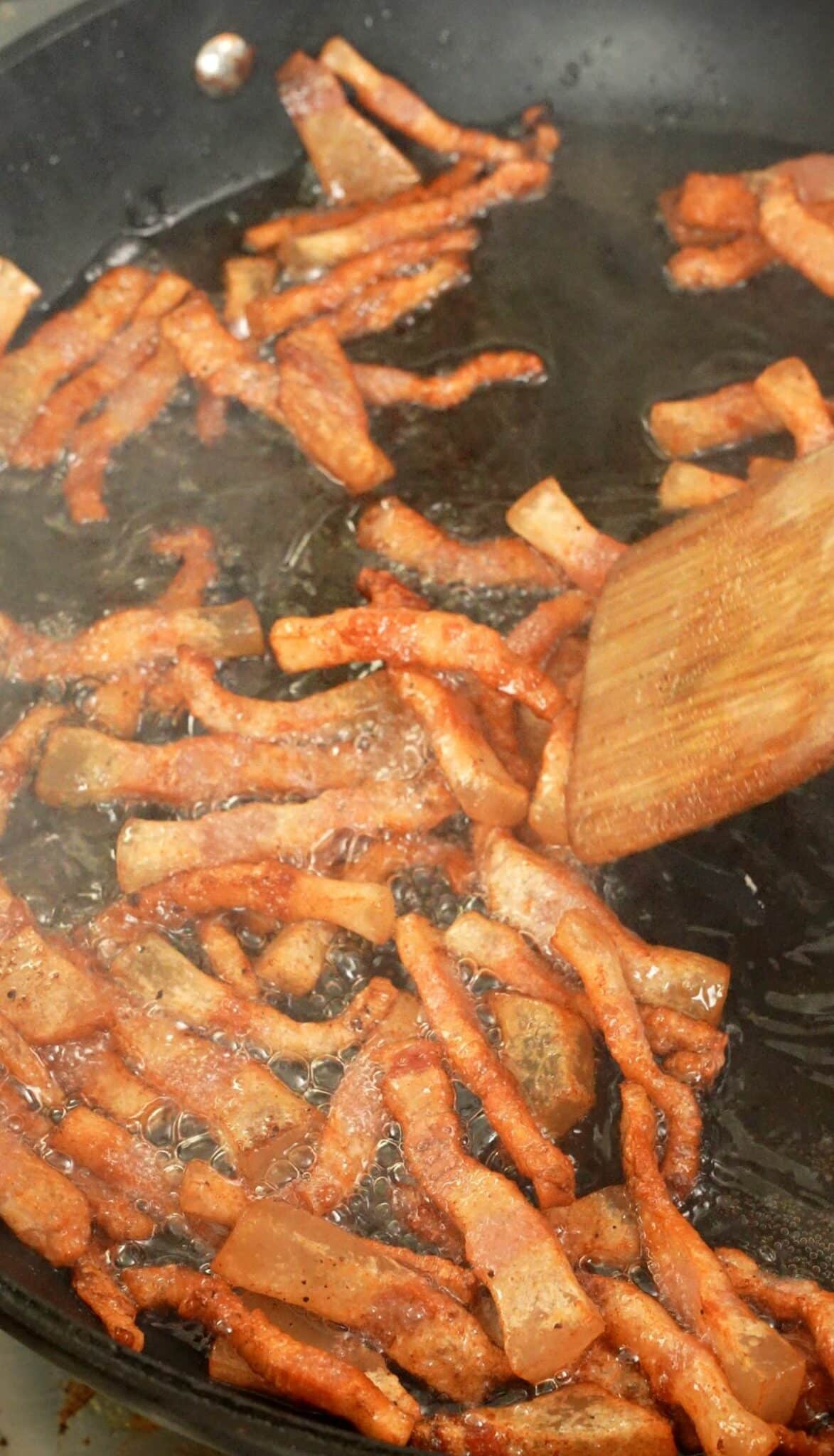
4. Drain the Guanciale Fat and Start the Sauce
Use paper towels to drain excess guanciale fat leaving about 3/4 cup, which is perfect for about 1 pound of pasta. Turn off the heat and add a ladle full of starchy pasta water to the pan to stop the guanciale from cooking further and start the sauce.
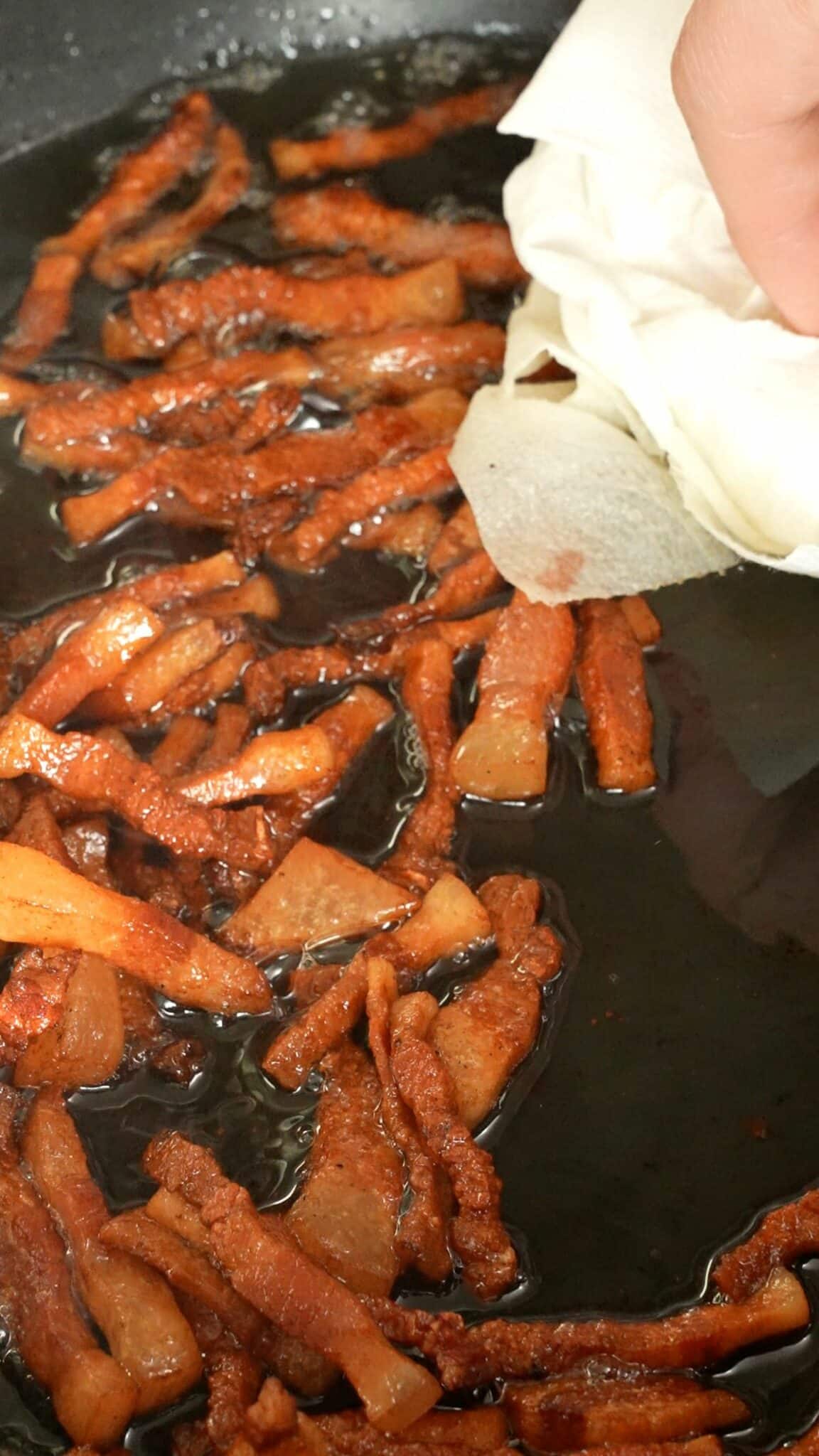
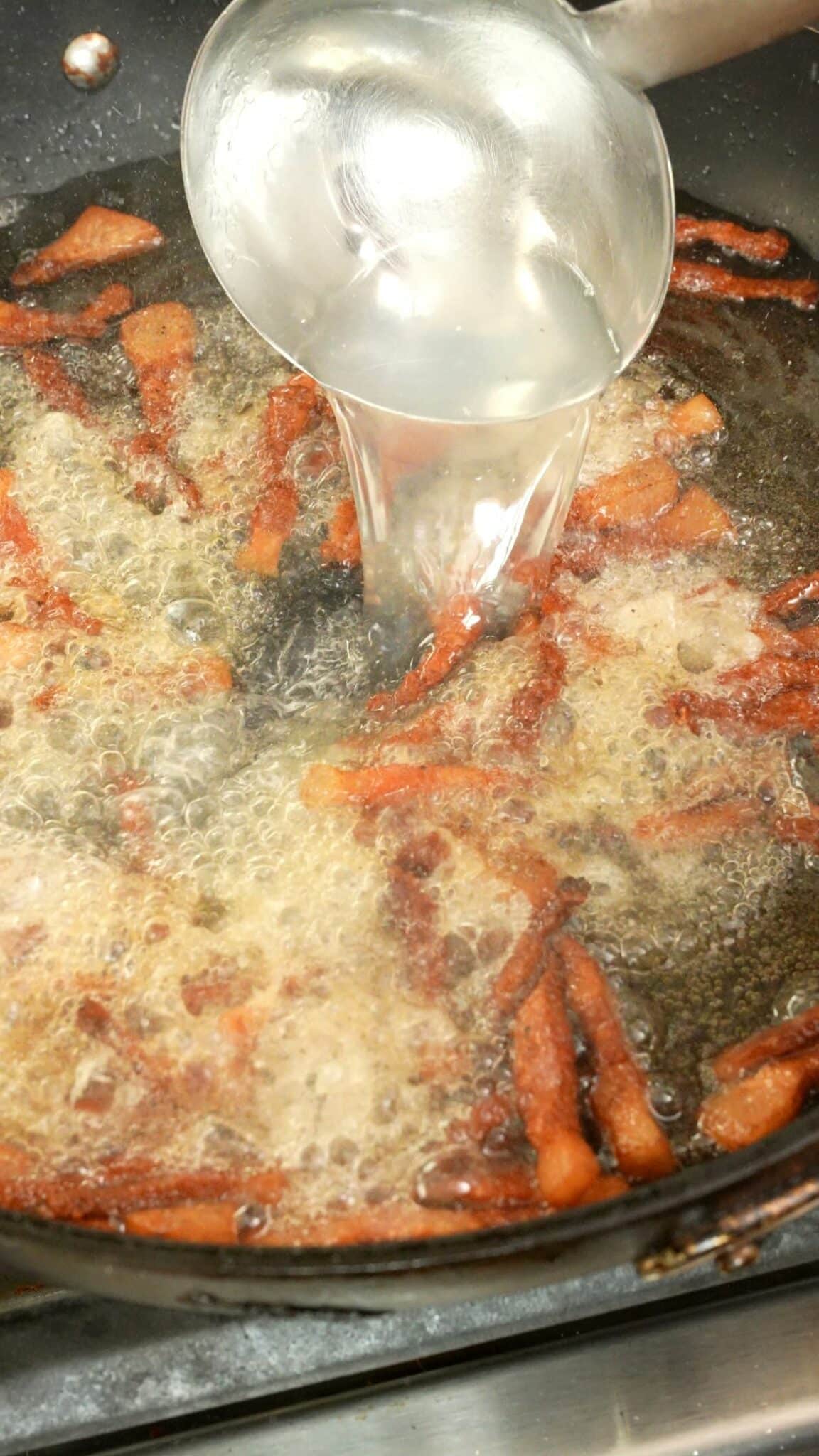
5. Add the pasta, pepper, cheese and emulsify the sauce
Add the strained pasta directly to the pan along with the pepper. Mix until well coated.
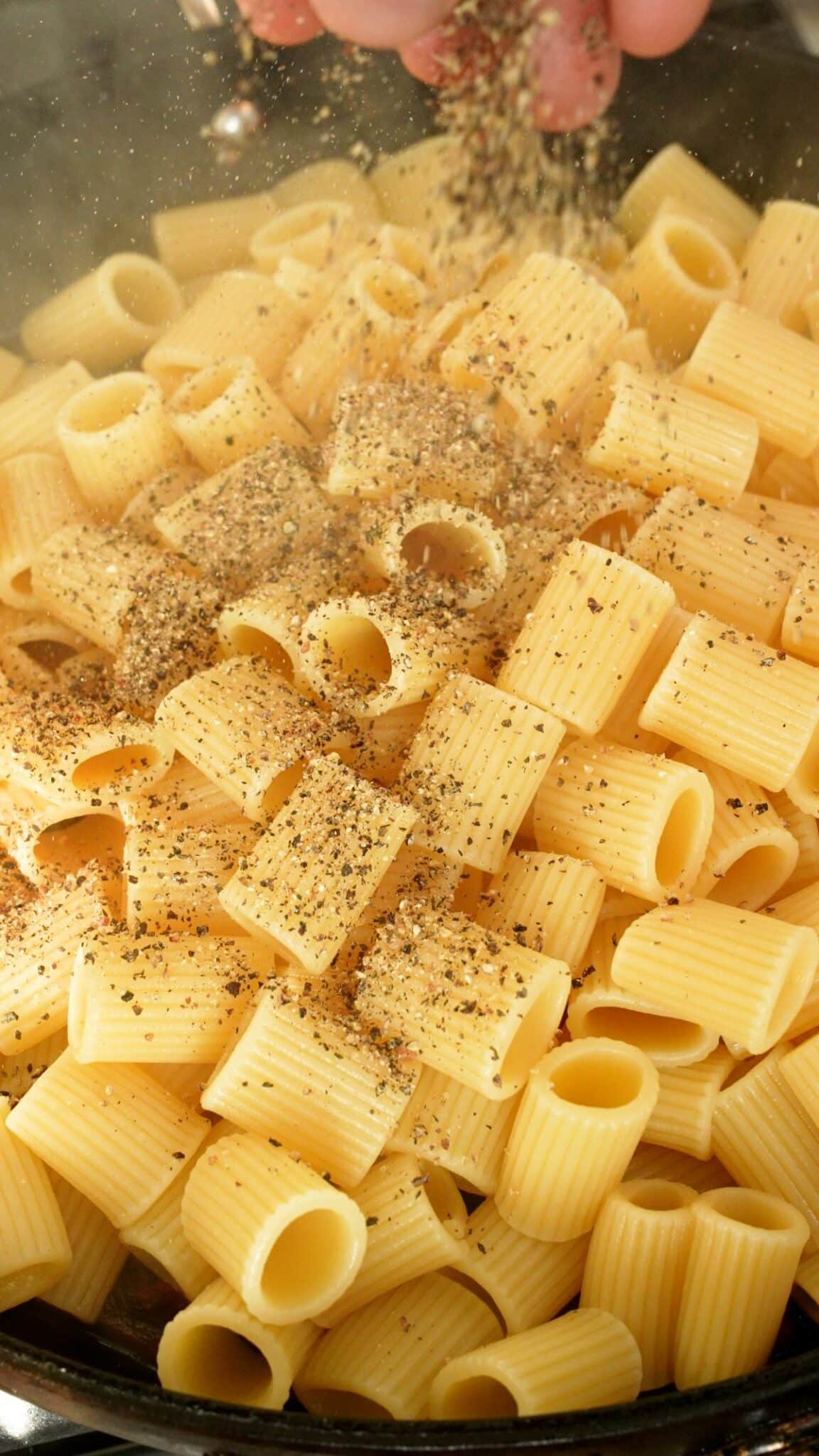
Transfer everything to a large metal mixing bowl and place it over the steaming pasta water that’s over low heat.
Let the pasta cool slightly before adding the cheese. I find that waiting 2-3 minutes does the trick (the temperature of the water you added should be 160F if you want to be exact). Adding the cheese while the water is too hot will cause the cheese to clump up, and we want to avoid this. Add the pecorino cheese a few handfuls at a time, mixing and tossing so that the cheese emulsifies with the pasta water and guanciale fat.
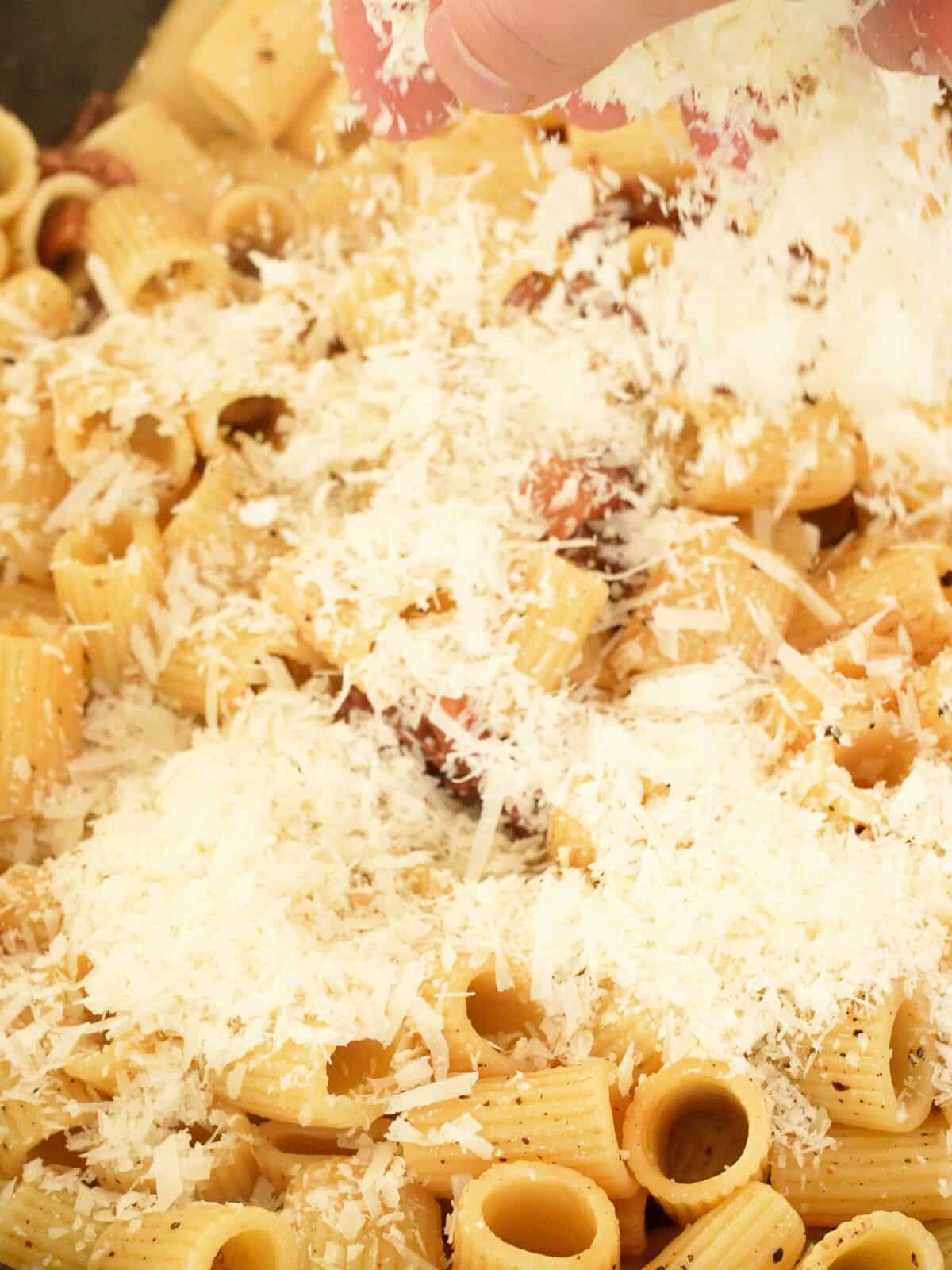
Mix, then continue adding 1/2 ladle full of pasta water at a time and mix to loosen the sauce. The result should be a creamy, emulsified sauce. Serve on a warm plate and enjoy.
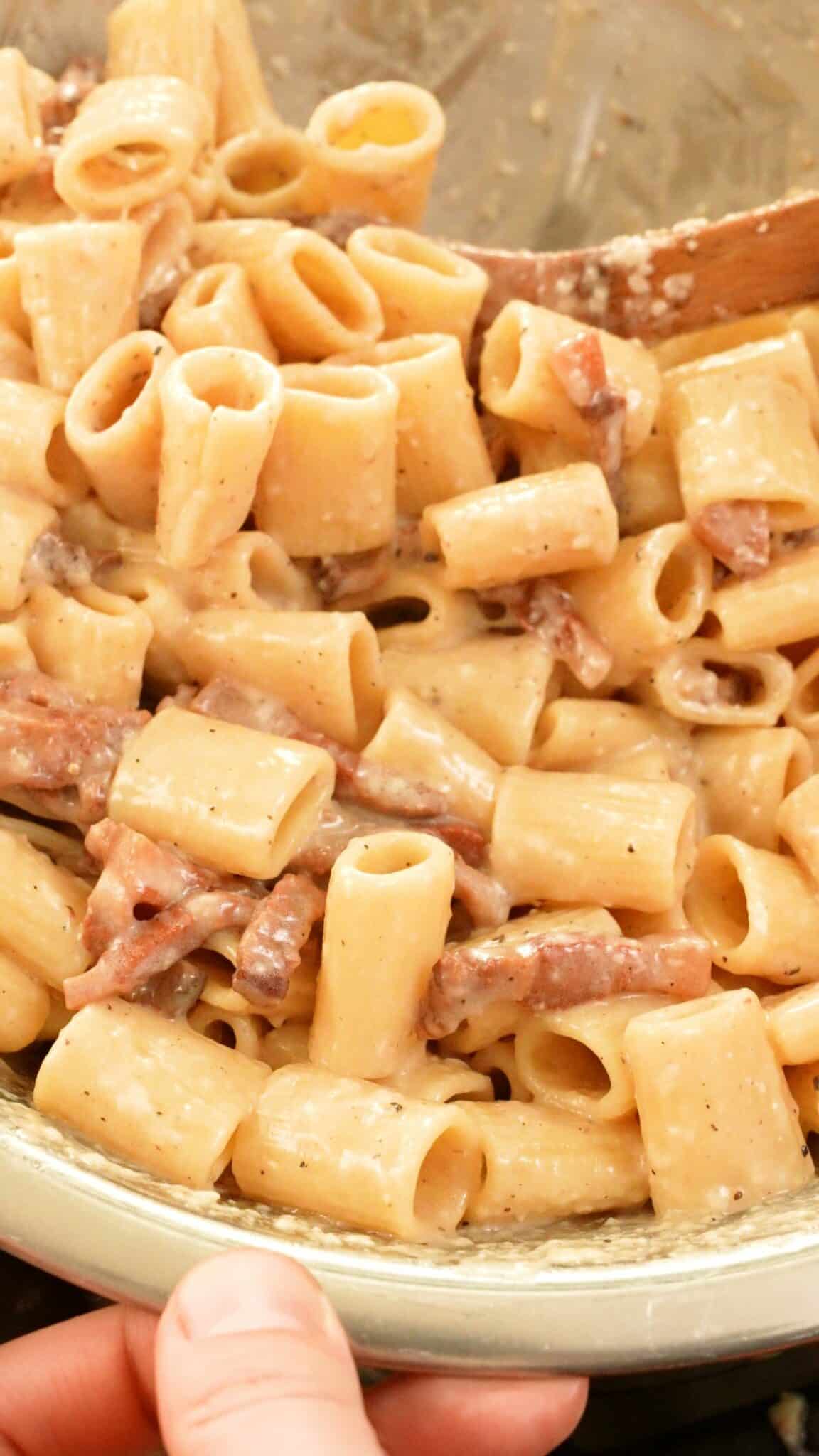
What Should I Serve with Pasta alla Gricia?
In traditional Italian restaurants, the pasta dish is usually the starter before the main course. You could pair this richer pasta with a lighter main dish like a Pan Seared Chicken Breast or Pan Seared Salmon with a freshing Crispy Rice Salad!
If you love pasta, try a few other of my most popular pasta dishes like my Baked Mac and Cheese, Fettuccine Alfredo, or Garlic Noodles with crab!
PRO TIPS
CJ’s Tips
- Ensure that your pecorino romano is finely grated. This will allow it to melt quickly and you’ll have an easier time emulsifying it into the sauce.
- Be aware of how much salt you use in the pasta water: In this case, you do not want your pasta water extremely salty because it is essential for emulsifying the sauce. This is why I only use ½ tablespoon of kosher salt for every 5 quarts of water, just enough to season the pasta. Since the pecorino and guanciale brings a lot of salt to the dish, you do not want to add pasta water that is too salty. You can always add salt if needed, but you can’t take it out!
- If the sauce is too thick: Add more pasta water to loosen the sauce, but ensure that the water is not boiling, otherwise it will cause the cheese to clump. The temperature of the water should be around 130-140F before coming in contact with the cheese. This is my top tip to ensure the cheese does not clump.
- If the sauce is too thin (you added too much pasta water): simply add more grated pecorino romano cheese to thicken up the sauce. Be aware that the sauce will also thicken overtime as it sits.
- Serving tip: Serve the pasta in a hot bowl to prevent the sauce from congealing quickly! I use a restaurant trick of adding hot pasta water to the bowl to warm it up, then dump it out just before I plate it with the pasta.
Storage, Reheating, and Make Ahead Tips
This pasta is best served hot and fresh, so I wouldn’t recommend making it ahead of time. If you need to store leftovers, place it in an airtight container in the fridge for up to a week. To reheat, place a damp paper towel over the pasta and reheat for 2 minutes at a time until the pasta is warmed through.
If you tried this Pasta alla Gricia Recipe or any other recipe on my website, please leave a 🌟 star rating and let me know how it went in the comments below!
Pasta alla Gricia – Authentic! (VIDEO)
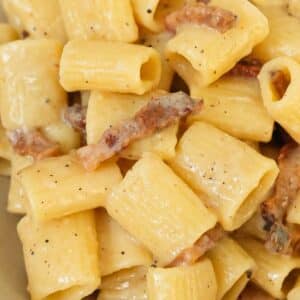
Ingredients
- 10 oz guanciale
- 1/2 tablespoon kosher salt
- 1 teaspoon freshly ground black pepper
- 16 ounces uncooked pasta, (mezzi rigatoni, rigatoni, thick spaghetti or bucatini)
- 4 ounces Pecorino Romano, finely grated
Instructions
- Remove the tough outer rind from the guanciale. Slice the guanciale into ½ inch thick slabs, then into thin strips.
- Bring a pot of boiling water (5 quarts) to a boil. Add the kosher salt and add the pasta of choice. Cook until al dente. Keep the pasta water hot over low heat after transferring the pasta in step 4.
- As soon as the pasta is cooking, to a dry nonstick pan, add the guanciale. Turn the heat to medium high and cook the guanciale for 5-6 minutes until the guanciale is a deep golden brown and crispy and the fat has rendered. Use paper towels to drain excess guanciale fat leaving about 3/4 cup. Turn off the heat and add a ladle full of pasta water to the pan to stop the guanciale from cooking further.
- Add the strained pasta directly to the pan along with the pepper. Mix until well coated. Transfer everything to a large metal mixing bowl and place it over the steaming pasta water that's over low heat.
- Add the pecorino cheese a few handfuls at a time, mixing and tossing so that the cheese emulsifies with the pasta water and guanciale fat. Mix, then continue adding 1/2 ladle full of pasta water at a time and mix to loosen the sauce. The result should be a creamy, emulsified sauce. Serve on a warm plate and enjoy.
Notes
Nutrition
Nutrition information is automatically calculated, so should only be used as an approximation.

